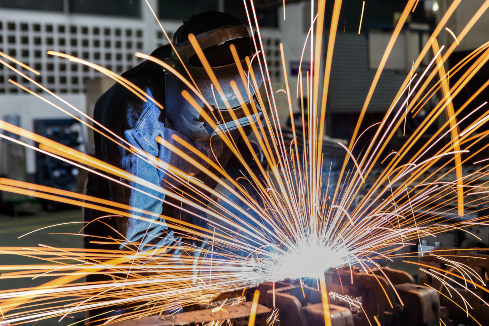
Standard ISO 11611
Protective Clothing for Use in Welding and Allied Processes
Workers performing welding work or using allied processes are exposed to the risk of burns by flames, sparks and sprayed molten metal particles. They are also exposed to the risks of burning objects, the heat released by the process and ultraviolet radiation. Flames, sparks and molten metal particles can penetrate or set fire to clothing and cause severe burns. Combustible dust produced during grinding and sanding can accumulate on workers and their clothing, and can be ignited by a spark.
The standard ISO 11611 specifies minimum basic safety requirements and test method for protective clothing including single garment suits, e.g. coverall or boiler suits, two-piece garment, consisting of a jacket and a pair of trousers, hoods, aprons, sleeves and gaiters.
Those protective clothing are intended to protect the wearer against spatter of molten metal, short contact time with flame, radiant heat from an electric arc used for welding and allied processes, and minimizes the possibility of electrical shock by short-term , accidental contact with live electrical conductors.
In Québec, workers were burned and some lost their lives as a result of burns caused by the burning of their clothing during welding or allied processes. These workers are welders, mechanics, laborers, carpenters, roofers, machine tool drivers, metalworkers.
The employer must provide the worker with protective equipment appropriate to the nature of his work and must ensure that it is safe and maintained in good condition. This certification program for protective clothing used in welding and allied processes will provide employers and users with additional information to confirm that they are buying or wearing safe clothing.
- Download standard
-
Program development committee members
Number of committee members : 12
Jean-François Gallego CINTAS Caroline Godin Multi Prévention ASP Robert Hébert LH Uniforme Lucie Huberdeau Commission des normes, de l'équité, de la santé et de la sécurité du travail (CNESST) Valério Izquierdo Groupe CTT Nicolas Juillard Textiles Monterey Jill Langlais Canam-ponts Sylvio Nolet Commission scolaire de la Capitale Nathalie Savard Noriske Karim St-Pierre TMS Système Williams Tarlotin Nova Bus Patricia Vega Association sectorielle fabrication d'équipement de transport et de machines
Certification offer
Protective clothing manufacturers can have the BNQ certify their products under a program established specifically for this purpose. The program is developed from the requirements of the standard ISO 11611. The certification protocol BNQ 1923-611 establishes the certification requirements and procedural rules applicable to the certification of the protective clothing. This protocol is complementary to the general rules of procedure found in the document BNQ 9902-001.
The program requirements concern the following in particular:
- the design of the protective clothing and additional protective garments (sizes, fit, pockets, flaps and seams);
- the performance classification;
- the tensile strength, tear strength, burst strength and dimensional change of material and seam;
- limited flame test, impact of molten metal spatter, heat transfer test and electrical resistance test;
- the marking, information supplied, care and maintenance;
- the manufacturer quality system.
-
Download document required for certification
langue = en
-
Certified businesses
Total number :3
1 Estrie CODET INC. 1 Estrie CODET INC. 1 Saguenay-Lac-Saint-Jean ÉQUIPEMENT SAGUENAY (1982) LTÉE (NORISKE) 
- Press review (French only)
-
Contact
Daniel Gagnon, P. Eng.
Program Leader
Bureau de normalisation du Québec
Cell.: 581-990-8778This email address is being protected from spambots. You need JavaScript enabled to view it.









